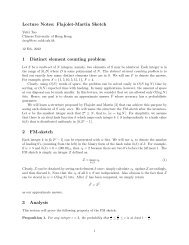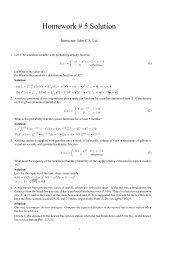Dynamic Bayesian Approach for Detecting Cheats in Multi-Player ...
Dynamic Bayesian Approach for Detecting Cheats in Multi-Player ...
Dynamic Bayesian Approach for Detecting Cheats in Multi-Player ...
Create successful ePaper yourself
Turn your PDF publications into a flip-book with our unique Google optimized e-Paper software.
1<br />
2<br />
3<br />
4<br />
5<br />
6<br />
7<br />
8<br />
9<br />
10<br />
11<br />
12<br />
13<br />
14<br />
15<br />
16<br />
17<br />
18<br />
19<br />
20<br />
21<br />
22<br />
23<br />
24<br />
25<br />
26<br />
27<br />
28<br />
29<br />
30<br />
31<br />
32<br />
33<br />
34<br />
35<br />
36<br />
37<br />
38<br />
39<br />
40<br />
41<br />
42<br />
43<br />
44<br />
45<br />
46<br />
47<br />
48<br />
49<br />
50<br />
51<br />
52<br />
53<br />
54<br />
55<br />
56<br />
57<br />
58<br />
59<br />
60<br />
61<br />
62<br />
63<br />
64<br />
65<br />
4 S.F. Yeung, John C.S. Lui<br />
lock-step protocol on a distributed game model where<strong>in</strong> players<br />
will announce their decisions <strong>in</strong> cryptographically secure<br />
one-way hashes as commitments. Only when all players<br />
have announced their commitments, players then reveal<br />
their decisions <strong>in</strong> pla<strong>in</strong>text. Thus, a cheater cannot ga<strong>in</strong> any<br />
advantage by be<strong>in</strong>g the last player to make decision. The<br />
authors also proposed some optimizations to overcome the<br />
synchronization problems caused. In [6], authors proposed<br />
a scheme that en<strong>for</strong>ces the fair-order<strong>in</strong>g of the message delivery<br />
so that cheat<strong>in</strong>g will be restricted to a certa<strong>in</strong> level<br />
or may even be detected. In [8], author extended the idea<br />
so that the cheat-proof protocol can be used <strong>in</strong> games with<br />
dead reckon<strong>in</strong>g. In [11], authors proposed the use of runtime<br />
verification to verify game codes. This approach ma<strong>in</strong>ly<br />
targets on cheats that exploit implementation bugs such as<br />
trade-hack <strong>in</strong> MMORPG, but this approach is not applicable<br />
to cheats that <strong>in</strong>volve modification of client code that<br />
loads <strong>in</strong>to memory at runtime. In [9], authors proposed the<br />
use of CAPTCHA tests [3] to ensure the participation of human<br />
players <strong>in</strong> onl<strong>in</strong>e games. This approach is very effective<br />
aga<strong>in</strong>st the use of fully automated robots. However, the <strong>in</strong>sertion<br />
of the CAPTCHA tests can be quite annoy<strong>in</strong>g dur<strong>in</strong>g<br />
the play<strong>in</strong>g of an onl<strong>in</strong>e game. And this approach is not applicable<br />
to cheats whose only assist the human player where<br />
a human player is still <strong>in</strong>volved <strong>in</strong> the play<strong>in</strong>g. In [14], the<br />
author briefly discussed the disadvantages of statistical approach<br />
to cheat detection <strong>in</strong> the game Quake. However, the<br />
detection scheme mentioned simply sort out players whose<br />
shoot too accurate, but didn’t take other attributes or game<br />
states <strong>in</strong>to account.<br />
PunkBuster [4] is the first client-side cheat prevention<br />
system <strong>for</strong> commercial onl<strong>in</strong>e games. To play an onl<strong>in</strong>e game<br />
on a PunkBuster enabled server, the player must <strong>in</strong>stall the<br />
PunkBuster plug-<strong>in</strong> <strong>in</strong>to the game client, otherwise the game<br />
server will refuse the connection. The PunkBuster client per<strong>for</strong>ms<br />
real-time memory scans to search <strong>for</strong> any known cheats<br />
and hacks. If any cheats or hacks are found, the PunkBuster<br />
client will report to the PunkBuster server, the cheater will<br />
be removed from the game and all other players will be<br />
<strong>in</strong><strong>for</strong>med of this violation. However, PunkBuster was once<br />
rendered nearly useless due to the very fast development cycle<br />
of the very famous cheat called OGC. OGC is a multifunctional<br />
cheat targets <strong>for</strong> several onl<strong>in</strong>e FPS games <strong>in</strong>clud<strong>in</strong>g<br />
the very famous and popular commercial FPS game<br />
called Counter-Strike [18]. Representatives from PunkBuster<br />
asked <strong>for</strong> f<strong>in</strong>ancial and development support from Counter-<br />
Strike’s developer, Valve, but were turned down. Thus the<br />
<strong>in</strong>volvement of PunkBuster with Counter-Strike was over.<br />
Currently, PunkBuster is supported on 18 onl<strong>in</strong>e FPS games<br />
<strong>in</strong>clud<strong>in</strong>g the well-known Quake series.<br />
After Valve decided to <strong>for</strong>ego PunkBuster, Valve developed<br />
its own anti-cheat system called Valve Anti-Cheat (VAC)<br />
[19]. All game clients and game servers developed by Valve<br />
run VAC by default. Valve keeps much of VAC’s detection<br />
method secret, but it is believed that VAC uses hash detection<br />
to identify <strong>in</strong>dividual cheats. There<strong>for</strong>e, new cheats<br />
must be discovered and added to the VAC database. It is also<br />
possible that VAC detects processes that work like cheats,<br />
such as processes that hook on the game client at run-time.<br />
This once caused some problems such as false positive would<br />
be produced if a player runs the <strong>in</strong>-game MP3 player called<br />
HLamp.<br />
HLGuard [15], <strong>for</strong>merly called CSGuard, is a free serverside<br />
anti-cheat system <strong>for</strong> the famous commercial FPS game,<br />
Half-Life, and its many variations such as Counter-Strike.<br />
HLGuard conta<strong>in</strong>s a set of anti-cheat features and <strong>in</strong>cludes a<br />
wall-hack block<strong>in</strong>g function and an aim<strong>in</strong>g-robot detection<br />
rout<strong>in</strong>e. However, HLGuard uses a very simple algorithm<br />
<strong>in</strong> its aim<strong>in</strong>g-robot detection rout<strong>in</strong>e. Basically, it looks <strong>for</strong><br />
players whose kill other players <strong>in</strong> the way like an aim<strong>in</strong>g<br />
robot does, such as changes the aim<strong>in</strong>g direction dramatically<br />
with<strong>in</strong> a very short period of time and then stops at<br />
aim<strong>in</strong>g a target accurately [1] and [2]. The algorithm is too<br />
simple that many subsequent aim<strong>in</strong>g robots could not be detected<br />
by HLGuard properly. For this reason, the detection<br />
rout<strong>in</strong>e has been disabled by default <strong>in</strong> the newer releases of<br />
the HLGuard.<br />
3 <strong>Bayesian</strong> Networks<br />
In this section, we provide a brief <strong>in</strong>troduction of <strong>Bayesian</strong><br />
network and its application <strong>in</strong> detect onl<strong>in</strong>e game cheat<strong>in</strong>g.<br />
A <strong>Bayesian</strong> network can be viewed as a graphical representation<br />
of causal relationships between different events. In<br />
general, a <strong>Bayesian</strong> network is an acyclic graph that consists<br />
of a set of nodes and a set of directed edges. Each<br />
node <strong>in</strong> a <strong>Bayesian</strong> network represents a random variable<br />
(i.e., which can have discrete or cont<strong>in</strong>uous outcomes), and<br />
each directed edge represents a causal <strong>in</strong>fluence from a parent<br />
node Xp to its child Xc. A node can have more than one<br />
parent, it implies that the random variable is dependent on<br />
many random variables (represented by all the parent nodes).<br />
A node can be parent of more than one node, <strong>in</strong> this case, this<br />
implies that the random variable can <strong>in</strong>fluence many other<br />
possible random variables (all its children nodes). We def<strong>in</strong>e<br />
the set of parent nodes of X as parents(X). The probability<br />
of a node X is conditioned on only its parent nodes and<br />
conditionally <strong>in</strong>dependent on other random variables. We<br />
say that P(A|B, C) = P(A|B) if B ∈ parents(A) while<br />
C �∈ parents(A). Thus, the jo<strong>in</strong>t probability distribution of<br />
a <strong>Bayesian</strong> network is given by:<br />
P(X1, X2, ..., Xn)<br />
= P(X1|parents(X1))P(X2|parents(X2))<br />
. . . P(Xn|parents(Xn)).<br />
To illustrate the applicability of this jo<strong>in</strong>t probability distribution,<br />
let us consider an example <strong>in</strong> Figure 1(a), which<br />
illustrates a <strong>Bayesian</strong> network that models the causal re-<br />
lationship between three random variables: Cheat<strong>in</strong>g( ˜ C),<br />
Distance( ˜ D) and aim<strong>in</strong>g Accuracy( Ã). In here, the random<br />
variables Cheat<strong>in</strong>g and Distance are parent nodes of<br />
Accuracy. There<strong>for</strong>e, whether the player is a cheater or not<br />
and his distance from the aim<strong>in</strong>g target can <strong>in</strong>fluence the






